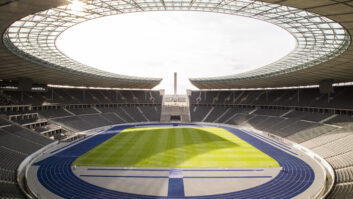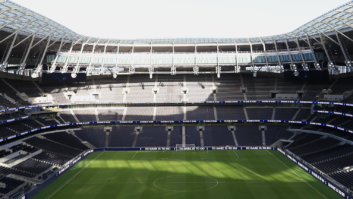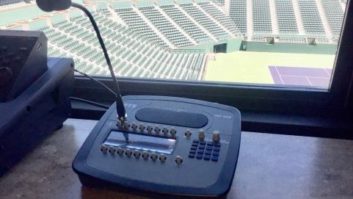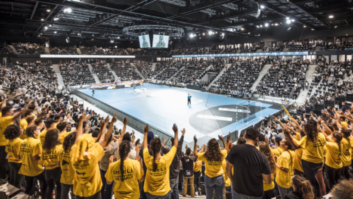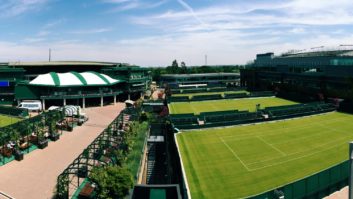Andy Murray’s success in getting to the Wimbledon final may lead to a surge in interest in the sport. TFA look at what’s involved in hitting a winner with the lighting. So Andy Murray didn’t quite make it. However, his heroic exploits in getting to the final, the first British player to get to the Wimbledon men’s final for 76 years, will no doubt spur on a few to dust down that old racket in the garage and ping a few balls around their local court. The Lawn Tennis Association (LTA) will certainly be hoping for a surge in interest. There’s work out there for architects as tennis clubs up and down the land improve facilities in line with the latest LTA guidelines. For example, the LTA now stipulates a lighting level of 500 lux on outdoor floodlit courts. Compton & Shawford Lawn Tennis ClubTake Compton & Shawford Lawn Tennis Club (pictured, top) for example. It had consisted of two courts, lit with Philips MNF 307 lamps. The lighting level achieved with this original solution reached 300 lux. However, since installation, the LTA guidelines for recommended lighting levels had been increased to 500 lux. The re-development of the club to include an additional court was the perfect opportunity to upgrade and improve the lighting system to comfortably satisfy the latest LTA revisions. The new floodlighting solution was created by LTL Contracts using the Philips Calculux Design Programme, comprising 12 Philips OptiVision MVP507s. These are asymmetric fittings which have been designed to be mounted with a horizontal front glass, allowing the floodlight to project light onto the court whilst offering the best possible beam control onto the playing area. The excellent control of light provided by Philips OptiVision means that light spill, glare and sky glow is kept to an absolute minimum. The new lighting therefore provides benefits to all the players at the tennis club whilst also respecting the needs of local residents, some of whom reside less than 50 metres from the floodlit courts.Compton & Shawford Tennis Club is delighted with the new floodlights. Elaine Grainger, the club project manager commented: “Everyone is extremely pleased with the results. There are absolutely no blind spots and the quality of light is excellent.”@page_break@
The West Worthing Tennis & Squash ClubAn installation at West Worthing has not only given a new lease of life to five of its courts, but will also save the club approximately £2,000 a year, as the scheme consumes almost 45% less energy than before. The West Worthing Tennis & Squash Club (pictured, above)was established in 1886, and prides itself on its commitment to provide top-quality facilities to people of all ages and abilities. For many years, the club has been able to offer its members seven floodlit tennis courts, so they could continue their enjoyment of the sport after dark and in the long winter months. However, it had become apparent that these floodlights were now out of date and in need of replacement. For a local club like West Worthing, it was important that the cost was kept to a minimum, while also ensuring that the minimum light levels set by the LTA were met. The Philips OptiVision floodlights were the perfect solution for their situation. The first phase of the redevelopment was to replace the 20 year-old MBIL metal halide fittings the club were using to light courts 5, 6 and 7. The 12 fittings, consuming 18kW of power in total, were replaced with eight OptiVision 2kW wide beam floodlights. Despite using fewer floodlights and saving 2kW of energy, the MHN-LA metal halide lamps were easily able to reach the required lighting levels. After the successful installation of phase 1, the club was keen to revitalise the lighting on a further two courts in front of the clubhouse (courts 1 & 2), as they now looked distinctly inferior to the newly-lit courts. The six columns, each fitted with 3 x 1.5kW tungsten halogen floodlights, provided an average light level of just 200 lux, well below the LTA recommended guideline. Thanks to the powerful asymmetric beam now available, these 18 fittings have been replaced by just four 2kW and two 1kW Philips OptiVision wide beam floodlights. As a result, the club is only consuming 10kW of energy, as opposed to the 27kW it was using with the previous fittings. Based on an energy tariff of 12p per kW/hour and 1,050 hours usage a year, this will provide a saving of £2,142, the equivalent of £2.04 an hour. In addition, maintenance costs are dramatically reduced, as the lamps will not need to be replaced as regularly as they were previously.@page_break@The Wentworth ClubThe Wentworth Club (above), synonymous with golf, is also one of the most exclusive tennis and health clubs in the UK. Set in the idyllic Surrey countryside, the club prides itself on its immaculately kept grounds, and up-to-date technology. However, this doesn’t just stop at gym equipment, but also extends to the lighting used on its tennis courts. Until recently there were six floodlit courts, each using eight ‘green box’ 1kW floodlights to provide the lighting requirements set out by the LTA. However, when it came to the redevelopment of a further four courts, the club had the choice of either keeping with the old technology, or switching to the Philips OptiVision floodlights. They selected the latter, but before the floodlights were installed, the three courts were stripped and relaid by the sports pitch construction specialist Doe Sport. It used the Doe Olympus artificial grass surface, and included cable ducts to help with the installation process of the floodlights later on in the year. This was completed while working closely with LTL Contracts to ensure a successful outcome. “After evaluating all the options, the OptiVision was selected for the additional court lighting and not only did it offer excellent performance on court, it also met the stringent planning requirements of the local authorities,” said Ian Hounsham of LTL Contracts. The 1kW OptiVision floodlights were the perfect choice for a number of reasons. With the horizontal flat glass providing excellent light cut-off at 80 degrees, the Upward Light Ratio (ULR) is kept to zero and there is minimal light spill. With the asymmetric beam providing peak intensity at 60 degrees, the recommended lighting level of 500 lux set by the LTA was easily reached. Also, as only six fittings were required per court, the club immediately experienced a 25% reduction in energy costs in comparison with the existing lighting. Replacement and maintenance costs are also reduced, as the MHN-FC lamp life to 20% failures is a remarkable 9,500 hours. As well as the minimal light spill to reduce the impact on the surrounding wildlife, the floodlights are painted green to make them more aesthetically pleasing, ensuring they blend in with the surrounding trees during the day. Not only can the club now boast Championship Tennis Courts to match its Championship Golf Courses, the extra three floodlit courts are an attractive proposition to entice new members, as well as enabling more of their members to enjoy a game of tennis throughout the long, dark winter months. The club can also hold more coaching sessions and arrange more tournaments than they could previously accommodate. Maybe some of these clubs will unearth the next Andy Murray and they can go one further and become Wimbledon Men’s Champion.
Sports facilities – Anyone for tennis?
Andy Murray’s success in getting to the Wimbledon final may lead to a surge in interest in the sport. TFA look at what’s involved in hitting a winner with the lighting.
